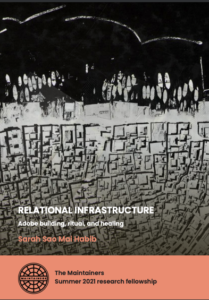“RELATIONAL INFRASTRUCTURE: Adobe building, ritual, and healing” by Sarah Sao Mai Habib
You can download Sarah’s report here.
“I believe the revival and contextual adaptation of adobe, earthen and woven architectural practices to be a move towards answering some of these questions. I believe this to be one way oppressed peoples can reclaim ancestral technologies and move towards housing sovereignty, and total sovereignty.”
Summary
This piece expands on the ideas of home sovereignty (in context of other sovereignty work, intersectional healing, and kinship beyond borders) through the framework of adobe – a building material made of earth and other natural elements. It is an offering consisting of eight parts that weave in and out of the specificities of current & historic adobe use in New Mexico/Pueblo Land and globally. Each part builds off one another, and can exist on their own.
Key Insights
-
When the author immersed herself in the world of adobe in New Mexico/Pueblo Land, it quickly became clear that knowledge lives within people and places, not recorded or documented. In her view “ the adobe buildings that still stand today are embodied archives of the required relationship and reciprocity, which the buildings are simultaneously a result of and conduit for”.
-
The idea of time from a non-linear perspective “This understanding of time is marked by events and ceremonies rather than linear numbers or accumulation. Across the globe many native communities hold rituals & blessings for both the process of building and maintaining homes.”
-
How the western idea of the individual over the collective impacts the development of buildings- the design of home is placed over design of community space.
-
The complexities of appropriation, and how the iconic adobe architecture of California that is popular to this day embeds the history of Spanish missions. “What is left out in the public narratives of these buildings is the fact that they were built by indigenous slave labor, and are sites of marked and largely unmarked graveyards.”
- “I will describe seven scales or circles of relationships that working with adobe and mud have given me a deeper understanding of.
- My relationship to self and purpose.
- The relationship of the materials adobe consists of, and the elemental relationships in the process of adobe making.
- The relationship of builder to soil, land and respectful harvesting.
- The relationships formed with people & community that have enabled, encouraged, and deepened my consciousness & understanding of earthen building.
- The relationship of the many hands & labor this work asks for.
- The relationships of building and maintaining physical vessels for living & nourishing the body, home & community.
- The relationship with what is bigger than us, the creative force, cosmos, time & space, and the cycles of life, death and transformation.”
- Multiple dimensions of colonization: ideas of space, time, and how the pretext of sustainability is used to gentrify and extract. In contrast, indigenous research and knowledge are centered on reciprocity, and not taking more than you need.
-
The complications and the inherent tension of producing reports from direct experience and oral tradition, that the author acknowledges in an exercise of restorative alchemy.
-
The importance of never invisibilizing trauma and harm (e.g. “mining of the human spirit”), is always brought to the forefront. The acknowledgment of this is the way to build a path forward.
For more on Sarah’s work, check out: Home Sovereignty Studio: patreon.com/homesovereignty // ig: @homesovereignty
